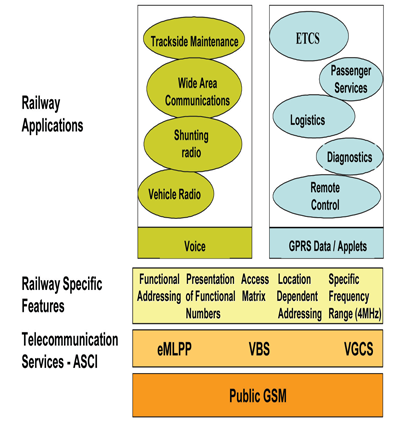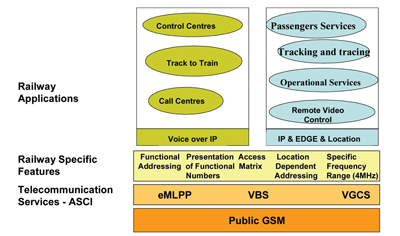ERTMS: offering an end-to-end solution to all transport organisations
Posted: 3 December 2008 | | No comments yet
GSM-R is the bearer for ERTMS/ETCS, the European Train Control System, gradually introducing a true intelligent traffic management system all over the railway lines in Europe. This global system is now extending to several countries worldwide as a recognised operating system.
GSM-R is the bearer for ERTMS/ETCS, the European Train Control System, gradually introducing a true intelligent traffic management system all over the railway lines in Europe. This global system is now extending to several countries worldwide as a recognised operating system.
The European new generation digital radio communication system based on GSM, called GSM-R is implemented in several countries. As per 2007, it entered full nationwide commercial service in Sweden for Banverket, in Germany for DB, in the Netherlands for Prorail, in Norway for Jernbanverket and in Italy for RFI. It also entered partial operational service in several additional European countries.
Indian Railways, China Railways, in Middle East Saudi Arabia, all North African Railways and several other countries in western and Eastern Europe are either in the planning phase or considering its introduction in their networks.
In addition, GSM-R is the bearer for ERTMS/ETCS, the European Train Control System, gradually introducing a true intelligent traffic management system all over the railway lines in Europe. This global system is now extending to several countries worldwide as a recognised operating system.
It allows Transport Services to migrate towards a Users oriented system and service. This evolution, driven by services and cost improvement, is the corner stone allowing for an evolution towards worldwide Intelligent Public Transport Systems and Services (IPTS).
The drivers for evolution toward ERTMS
With its stable specifications and tested products, ERTMS/ETCS is now seen as the right answer when renewing signalling equipment. The obsolete nature of the traditional signalling systems, their high costs, especially as regards maintenance, and their incompatibility mean that all the stakeholders see ETCS as the only signalling option for the future trans-European rail networks.
ERTMS integrates the components necessary for an evolving rail traffic management system composed of GSM-R, ETCS, ETML and Euro-Interlocking functions.
The basis for intelligent transport services
The architecture of an Intelligent Transport Service
The basic intelligent transport system includes the following components:
- Data acquisition system
- Secure data processing or information system
- Transmission and location network for information transport and location stamp
- Presentation of information to end user
ERTMS as an Intelligent Transport System
The principles given above apply completely to ERTMS with Data acquisition through the On Board Unit and the processing by the central system using GSM-R as a bearer. The location is based either on beacons as per today or Satellite systems such as Galileo in the future. The DMI on board presents the processed information to the Driver as well as the Dispatcher end users based on an evolving context processed by the centralised computer unit. This system is a corner stone of a sustainable transport system.
It is ‘intelligent’ since its capacity to address the present as well as the future needs through software evolution. It allows evolution with the introduction of modern interlocking systems as well as being able to use the availability of secure information systems to develop new applications allowing for the improved operations of Railways.
GSM-R intelligent features and functions
The GSM-R benefits from the GSM data transmission and includes General Packet Radio Service (GPRS) which would allow efficient adding of new applications such as ETCS, operational services such as logistics, diagnostics, remote control, passenger services through access of railway staff to data bases through intranet, time scheduling and tariffs, automatic seat reservation to existing applications mainly based on voice transmission (see Figure 1 on page 83).
GSM evolution (see Figure 2) with Internet Protocol (IP), operational applications for rolling stock maintenance, optimised freight load management through tracking and tracing features as well as development of other on-board applications for passenger services such as ticketing, on-line information via internet and remote video control with EDGE allowing data up to 364 Kbit/s.
It offers end-to-end solutions for:
- Present railway applications such as the voice link between the driver and the dispatchers through the cab radio
- Future railway applications such as radio based signalling through ETCS as well as ticketing applications and passenger information display on board
In addition, SIM cards usage allows flexible differentiation of rights among groups of Users. The customisation of the services offered can be determined by the users.
The location dependent addressing feature allows geographic segregation when several dispatch areas are implemented in the operational network.
Conclusion
ERTMS offers all transport organisations an end-to-end solution for their Intelligent Transport System (ITS) Rail network. It is based on digital communication for voice and data.
Present Railway applications are now available on an integrated and standardised platform able to evolve with the users needs. The system is able to perform all the existing day to day operations and offer a platform for evolution.
High performance data transmission features of GSM-R allow new applications, such as IT systems for passenger’s information, on-board ticketing, diagnostics, maintenance and so forth.
Introduction of this new system represents for most of the transport organisations:
- A Reduction of operating costs
- A Reduction of maintenance costs (reduced spare parts and training costs)
- Increased spectrum efficiency
- High speed data applications and service differentiation with existing systems
- Reduced capital expenditure by using standard equipment
- Increased flexibility of operation
The transport organisations aiming at renewing their analogue, costly to maintain equipment, should consider the alternative of using ERTMS as the answer to their present and future needs. This system is widely deployed in Europe in far demanding railway environment. The ERTMS equipment is developed and several industries are able to offer it from the shelves provided that the frequency range is within the overall GSM 900 frequency range.
The selection of other frequency ranges, if mandatory, is to be carefully evaluated and we can offer our services to help transport organisations in evaluating and optimising their requirements to select the most appropriate solution and benefit from the most advanced technique.


Figure 1: Current and new applications


Figure 2: Adding new applications with GSM-R
Issue
Related topics
European Rail Traffic Management System (ERTMS), European Train Control System (ETCS), Global System for Mobile Communications – Railway (GSM-R)








